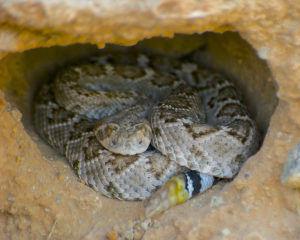Show of hands — who likes rattlesnakes? Many people who spend time on rangelands strongly dislike this particular type of wildlife. Just like all wildlife, though, rattlesnakes have their place in the ecosystem.
Next question: who likes rats? Who likes disease? Controlling pest populations is an important ecosystem service provided by rattlesnakes. Small mammals are the #1 prey of rattlesnakes, so rattlesnakes keep rodent populations in check which in turn can reduce the spread of zoonotic diseases carried by rodents.
Unlike other venomous snakes, rattlesnakes will often alert you to their presence. However, many ranchers and hunters have experienced times when rattlesnakes stay silent despite human proximity. Why might this occur? Next time you see a rattlesnake, check out its coloration. The rattlesnakes of Texas rangelands sport shades of brown, tan, and gray in bands and blotches, which makes for great camouflage! Ideally, snakes would rather not be detected by you or I, or any other predator, for that matter. When a snake detects a threat, it can respond aggressively (rattling and coiled posture) or passively (staying still and silent). Factors that can influence the snake’s response include ambient temperature, type of predator, and even the reproductive status of the snake.
Ambient temperature affects rattlesnake behavior because, like all reptiles, rattlesnakes cannot internally regulate their body temperature. In the fall and spring, snakes are likely to be found in warm, sunny places. In the summer, rattlesnakes often seek relief from the hot sun under rocks and bushes, and in crevices. A good tip to avoid snakebite, especially in the summer, is to watch where you put your hands and feet. Look before reaching under ledges and overhangs, and use a stick, shovel, or other tool to flip rocks or logs that need to be moved.

Watch where you step and grab to avoid snakebite. Western Diamondback Rattlesnake by wplynn, licensed under CC BY-ND 2.0.